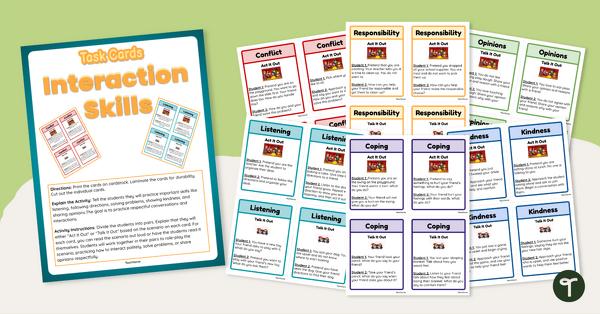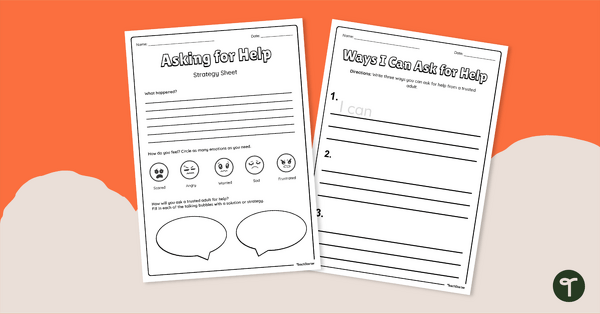Decision Making Skills Teaching Resources
Created by teachers, this collection of SEL teaching resources has been created with teachers — and your students — in mind. The goal? To save you time on your lesson plans while also helping you help your students to improve their decision making skills in a safe and supportive classroom environment!
Looking for some tips on teaching kids to make good decisions? Read on for a primer from our teacher team.
What Is Decision Making? A Kid-Friendly Definition
Do you need a kid-friendly definition to help explain what these skills are to your students? Try this one from our teacher team:
Decision making is a process of thinking carefully about different options, imagining what might happen next and then picking the best choice based on what you know and feel.
In order to do this, we use special skills or abilities that help us to make smart choices and think about what might happen next.
Decision Making Skill Examples
Presenting your students with examples of the different skills they may have without even knowing it, as well as those they can develop, is a great way to teach this key part of kids' social emotional learning.
For example, you might tell your second or third-graders that decision making skills can help us with all sorts of things like deciding which slide to use in the playground to what shoes to wear to school.
Here's a list of example skills we use for making decisions just about every day:
- Considering the Consequences of Our Actions — Thinking about what might happen as a result of different choices and deciding which outcome is desirable can help us make smart choices.
- Resisting Peer Pressure — Your students have no doubt heard about the importance of making independent decisions even when friends or others try to influence you. If not, it's time to talk about it!
- Planning Ahead — When we look ahead and make plans for things down the road, we are using our skills to evaluate what we will need to do and acting accordingly.
- Prioritization — Related to the skill of planning ahead is the process of determining what tasks or activities are most important and should be done first.
- Evaluating Risks — Whether we're deciding whether or not it's safe to cross a street or swing up high on a swingset, assessing the potential dangers or benefits of a choice before making a decision is an important life skill.
The Steps in the Decision Making Process
As you consider how to add this particular skill to your lesson plans, how about taking a look at the steps in the decision making process? After all, by the primary grades (kindergarten to second grade), many kids understand the concept of making choices and are starting to identify different options, as well as making simple decisions in their daily routines, such as choosing activities or snacks.
But they may not know where to go next or how to move beyond the first step of the larger decision making process.
Here's a simple step-by-step guide that may help.
Step 1 — Identifying the Problem
The process of decision what to do begins by recognizing that there's a problem or a situation that needs to be addressed. This could be in the form of a challenge, a goal you want to achieve, a choice you need to make or a decision to be taken. It's important to clearly understand what needs to be resolved or what the desired outcome is.
Questions to Ask Yourself
- What is the specific issue or challenge?
- What are the goals or objectives I want to achieve?
- What decision or action is required in this situation?
Step 2 — Gathering Information
In the second step, you begin collecting all the information you need to make a good decision. This step is a bit like collecting puzzle pieces so you can put them together. You might research the problem in a book or on the Internet, or you might ask a trusted adult or a friend for more information.
Questions to Ask Yourself
- What do I already know about this problem?
- What other information do I need?
Step 3 — Exploring Your Options
Once you have enough information, it's time to come up with the different choices or options that you could pick. For example, if your friend is coming to visit, and you want to plan a fun night, you may consider the different games you could play, movies you could watch and foods you could eat, among other options.
Questions to Ask Yourself
- What different choices do I have?
- What are the possible ways to solve this problem?
Step 4 — Evaluating Your Choices
Next, it's time to look at each option and think about the good and bad things that could happen if you choose it. You'll need to consider the consequences that will come with choosing any particular option — both negative and positive ones — as well as any additional considerations that may affect your decision.
For example, if we consider the upcoming friend visit, you may want to consider the weather forecast as an additional thing to consider. If it is going to rain, you may want to skip any options that involve spending time outside!
Questions to Ask Yourself
- What are the good things that could happen if I choose each option?
- What are the bad things that could happen?
Step 5 — Making a Decision
Now it's time for the big moment — making your decisions! Based on what you've learned and thought about, you will choose the option that you think is the best one to solve your problem or achieve your goal.
Questions to Ask Yourself
- Based on what I know and the pros and cons, which option do I think is the best?
- What feels right to me?
Step 6 — Taking Action
Once your decision is made, it's time to put it into action by doing what you chose.
Questions to Ask Yourself
- How can I put my decision into action?
- What steps do I need to take to implement my choice?
- Free Plan

I Set My Boundaries Worksheets
Identify your personal space boundaries with this worksheet set.
- Free Plan

My Safety Plan Worksheet
Create a safety plan to help understand what to do or who to go to when you feel unsafe.
- Plus Plan

Personal Space and Setting Boundaries Activity Set
Learn about personal space and appropriate boundaries with this activity pack.
- Free Plan

Asking for Help Comic Strip Template
Discuss how and who to go to for help using this comic strip template.
- Plus Plan

Think Sheet for Behavior – Lower Grades
Invite your primary students to reflect on their behavior choices with this behavior think sheet.
- Plus Plan

Behavior Reflection Sheet – Upper Grades
Get your students to reflect on their behaviors with this reflection worksheet.
- Plus Plan

Red Ribbon Week - Write the Room Activity
Use these Red Ribbon Week Writing prompts with your students during literacy centers.
- Plus Plan

Drug Awareness Week- Cause and Effect Paper Chain Activity
With a printable cause-and-effect paper chain activity, guide your students to discover the positive and negative effects of using drugs.
- Plus Plan

THINK Strategy - Think Before You Speak Poster
Promote positive communication using the THINK strategy and our printable Think Before You Speak Poster.
- Plus Plan

Big Problem or Little Problem? – Sorting Activity
Use our Big Problem vs. Little Problem activity cards and worksheets to help your students learn to manage peer relationships in the classroom.
- Plus Plan

Oral Language Activities
Share these oral language activities with your students to help them practice listening to others, expressing opinions, receiving instructions, and more!
- Plus Plan

Plus-Minus-Interesting Chart
Use this Plus-Minus-Interesting Chart set in any subject area to get your students talking!
- Plus Plan

Choices and Consequences Board Game
Encourage your students to think about the choices they make with this printable SEL board game.
- Plus Plan

Predicting Consequences Worksheet
Help your students anticipate the consequences of their actions with this SEL worksheet.
- Plus Plan

Reflecting on Choices Writing Prompt Pack
Encourage students to reflect on the choices they’ve made and their respective outcomes with this set of 8 writing prompts.
- Plus Plan

Peer Pressure Poster
Give your students strategies to deal with peer pressure by displaying and reviewing the tips on this classroom poster.
- Plus Plan

Self-Awareness Worksheet
Help your students build self-awareness by reflecting on the thoughts, feelings, and behaviors in the specific scenario outlined on this worksheet.
- Plus Plan

Making Good Choices Mini-Book
Help your students develop strategies for making good choices with this printable social story mini-book.
- Plus Plan

Analyzing Situations Sorting Activity
Use this sorting activity with your students to practice analyzing situations for their problems, consequences and possible solutions.
- Plus Plan

Rules for School Mini-Book
Remind students about appropriate behaviors at school with this printable mini-book.
- Plus Plan

Big Problem, Little Problem Posters
A set of posters that show different strategies for big problems and little problems.
- Free Plan

Asking for Help Strategy Sheets
Help students work through a difficult situation and how to ask for help with these asking for help strategy sheets.
- Plus Plan

Good vs. Bad Choices Interactive Quiz
Help your students differentiate between good and bad choices with an interactive quiz activity.
- Plus Plan

Behavior Think Sheet - Upper Grades
Invite your students to reflect on their behavior choices with this behavior think sheet.
- Plus Plan

Good Choice or Bad Choice? Worksheet
Help your students differentiate between good and bad behavior choices with a cut-and-paste worksheet.
- Plus Plan

Are We There Yet? – Growth Mindset Progress Chart
Help your students develop a growth mindset by reflecting on their learning progress with this progress tracking chart.
- Plus Plan

Personal Space Flipbook
Explore the concept of personal space and how it keeps us safe with this activity flipbook.
- Plus Plan

Feeling Safe Mini-Book
Explore positive and negative feelings and what it feels like to be safe with this mini-book.
- Plus Plan

How to Seek Help Mini-Book
Learn all about why, how and when you might seek help with this printable mini-book.
- Plus Plan

Safe or Unsafe Scenario Task Cards
Discuss safe and unsafe situations with this set of scenario task cards.
- Plus Plan

Is It Safe or Unsafe? Task Cards
Explore safe and unsafe situations with this set of task cards.
- Plus Plan

My Safe Relationships Flipbook
Explore what makes a safe relationship and who is in your trusted network with this flipbook.
- Decision Making Skills Worksheets
- Decision Making Skills Templates
- Decision Making Skills for Kindergarten
- Decision Making Skills for 1st Grade
- Decision Making Skills for 2nd Grade
- Decision Making Skills for 3rd Grade
- Decision Making Skills for 4th Grade
- Decision Making Skills for 5th Grade
- Decision Making Skills for 6th Grade